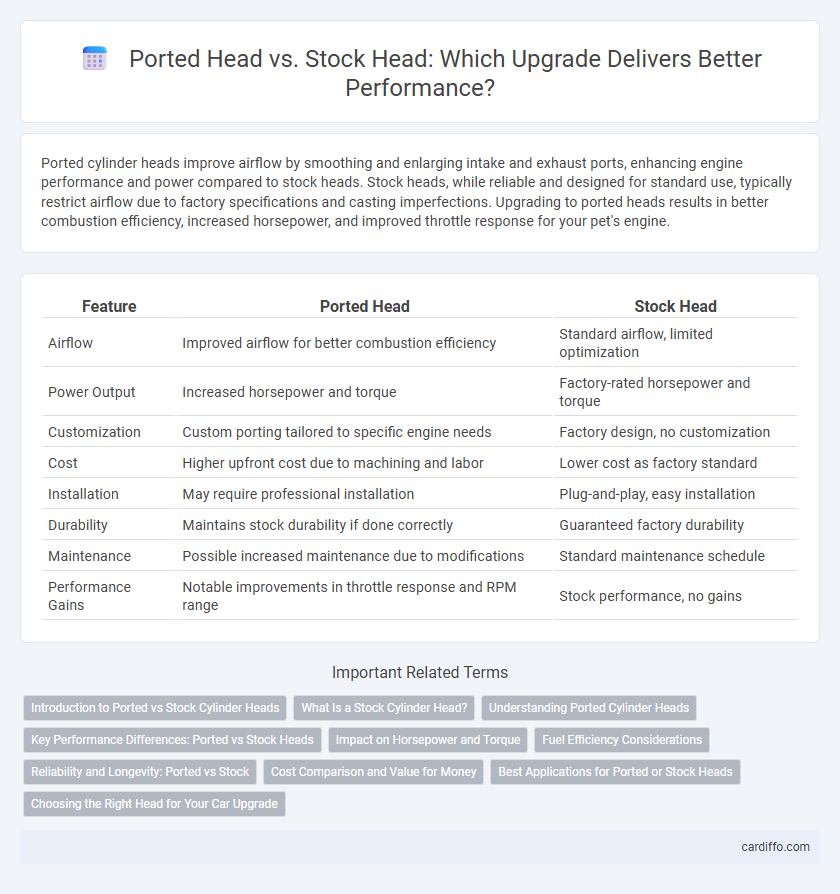Ported cylinder heads improve airflow by smoothing and enlarging intake and exhaust ports, enhancing engine performance and power compared to stock heads. Stock heads, while reliable and designed for standard use, typically restrict airflow due to factory specifications and casting imperfections. Upgrading to ported heads results in better combustion efficiency, increased horsepower, and improved throttle response for your pet's engine.
Table of Comparison
| Feature | Ported Head | Stock Head |
|---|---|---|
| Airflow | Improved airflow for better combustion efficiency | Standard airflow, limited optimization |
| Power Output | Increased horsepower and torque | Factory-rated horsepower and torque |
| Customization | Custom porting tailored to specific engine needs | Factory design, no customization |
| Cost | Higher upfront cost due to machining and labor | Lower cost as factory standard |
| Installation | May require professional installation | Plug-and-play, easy installation |
| Durability | Maintains stock durability if done correctly | Guaranteed factory durability |
| Maintenance | Possible increased maintenance due to modifications | Standard maintenance schedule |
| Performance Gains | Notable improvements in throttle response and RPM range | Stock performance, no gains |
Introduction to Ported vs Stock Cylinder Heads
Ported cylinder heads are optimized for improved airflow by reshaping and enlarging intake and exhaust ports, enhancing engine performance and efficiency compared to stock heads. Stock cylinder heads are designed for general use, prioritizing durability and compatibility but often limiting airflow capabilities. Upgrading to ported heads can result in increased horsepower and torque by reducing air resistance and improving combustion dynamics.
What Is a Stock Cylinder Head?
A stock cylinder head refers to the original equipment manufacturer (OEM) component designed specifically for a vehicle's engine, ensuring compatibility and reliability as intended by the manufacturer. These heads feature factory-optimized combustion chambers, valve sizes, and port shapes engineered to balance performance, emissions, and fuel efficiency within the engine's stock parameters. Upgrading to a ported head modifies these internal passages to enhance airflow for improved horsepower and torque but sacrificing the OEM refinement found in stock cylinder heads.
Understanding Ported Cylinder Heads
Ported cylinder heads improve engine performance by optimizing airflow through enlarged and smoothed intake and exhaust ports compared to stock heads, which have more restrictive factory designs. Enhanced airflow increases combustion efficiency, resulting in higher horsepower and torque output while supporting better fuel atomization and reduced pumping losses. Understanding the specific port shapes, sizes, and flow characteristics is essential for maximizing the benefits of ported heads in any engine upgrade.
Key Performance Differences: Ported vs Stock Heads
Ported cylinder heads enhance airflow efficiency by smoothing and enlarging intake and exhaust ports, resulting in increased horsepower and torque compared to stock heads. Stock heads typically feature smaller, less optimized ports that limit air and fuel mixture flow, restricting engine performance. Improved combustion chamber design and valve size in ported heads contribute to better volumetric efficiency and higher RPM power gains.
Impact on Horsepower and Torque
Ported heads significantly improve airflow by smoothing and enlarging intake and exhaust ports, resulting in increased horsepower and torque compared to stock heads. This enhanced efficiency allows the engine to breathe better, boosting combustion performance and power output. While stock heads are designed for balanced reliability and emissions, ported heads focus on maximizing engine performance through optimized airflow dynamics.
Fuel Efficiency Considerations
Ported heads improve airflow by enlarging and smoothing intake and exhaust ports, which can enhance combustion efficiency and potentially boost fuel economy. However, stock heads are engineered with optimized port sizes and shapes balanced for fuel efficiency and emissions compliance, making them more suitable for daily driving and achieving consistent mileage. Careful tuning is essential when using ported heads to maintain or improve fuel efficiency, as improper modifications can lead to increased fuel consumption.
Reliability and Longevity: Ported vs Stock
Ported heads enhance airflow efficiency, reducing engine temperatures and improving combustion, which can contribute to better reliability when properly executed. However, stock heads offer proven durability due to original manufacturer specifications and consistent material quality, ensuring predictable longevity under standard operating conditions. Careful machining and quality control in porting are crucial to maintain or exceed the reliability and lifespan associated with stock heads.
Cost Comparison and Value for Money
Ported cylinder heads offer improved airflow and performance gains but come at a significantly higher cost, often doubling the price of stock heads. Stock heads provide reliable durability and better cost efficiency, making them a practical choice for budget-conscious upgrades. Evaluating value for money depends on desired performance improvements versus initial investment and maintenance expenses.
Best Applications for Ported or Stock Heads
Ported heads excel in high-performance applications where increased airflow and combustion efficiency are critical, such as racing engines or heavily modified vehicles seeking maximum horsepower gains. Stock heads are best suited for daily drivers or mild performance upgrades, offering reliability, better fuel economy, and easier maintenance without extensive modifications. Choosing between ported or stock heads depends on the vehicle's intended use, budget, and desired power output.
Choosing the Right Head for Your Car Upgrade
Choosing between a ported cylinder head and a stock head depends on your performance goals and budget. Ported heads offer improved airflow and increased horsepower by reshaping intake and exhaust ports, making them ideal for high-performance builds. Stock heads provide reliability and compatibility, suitable for mild upgrades without extensive modifications.
Ported head vs stock head Infographic

 cardiffo.com
cardiffo.com